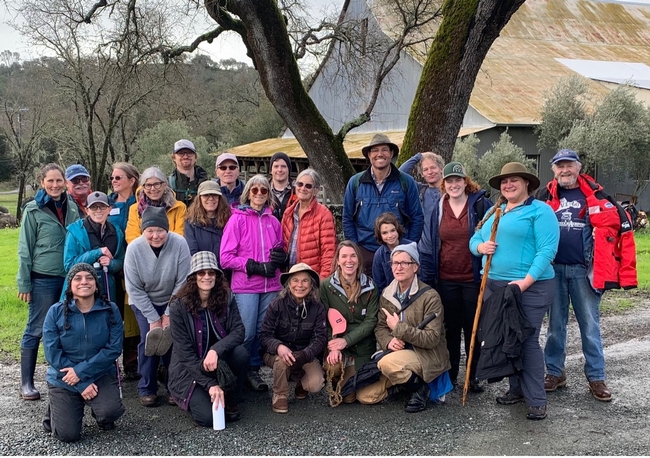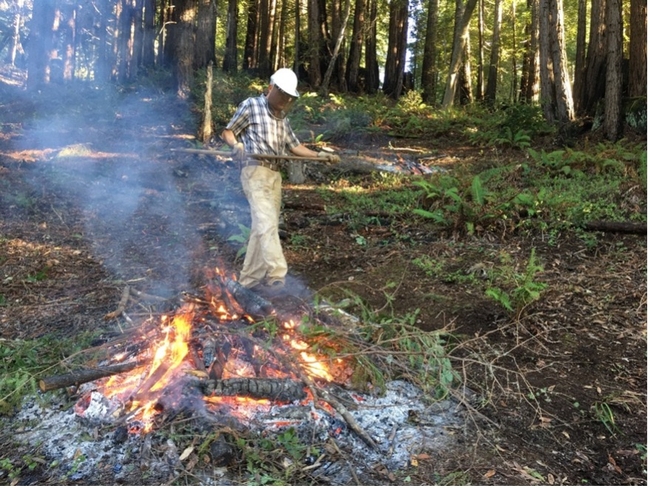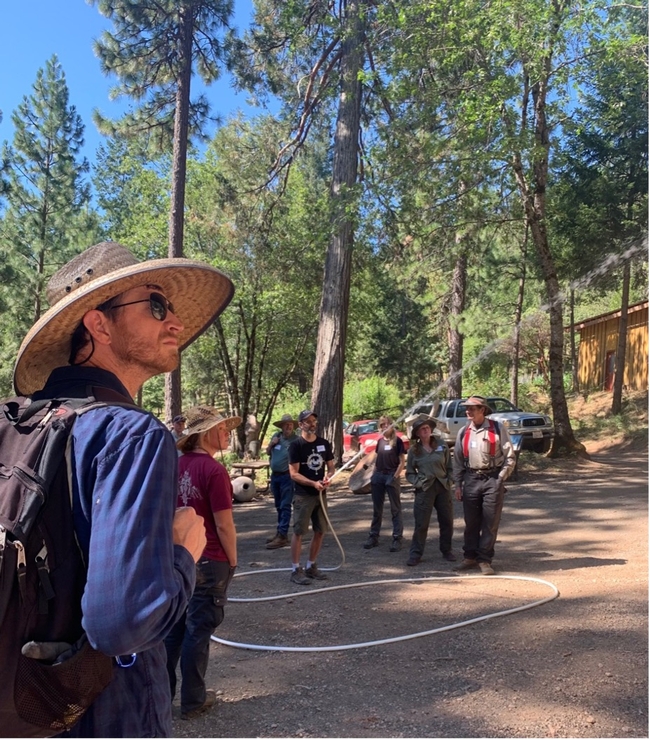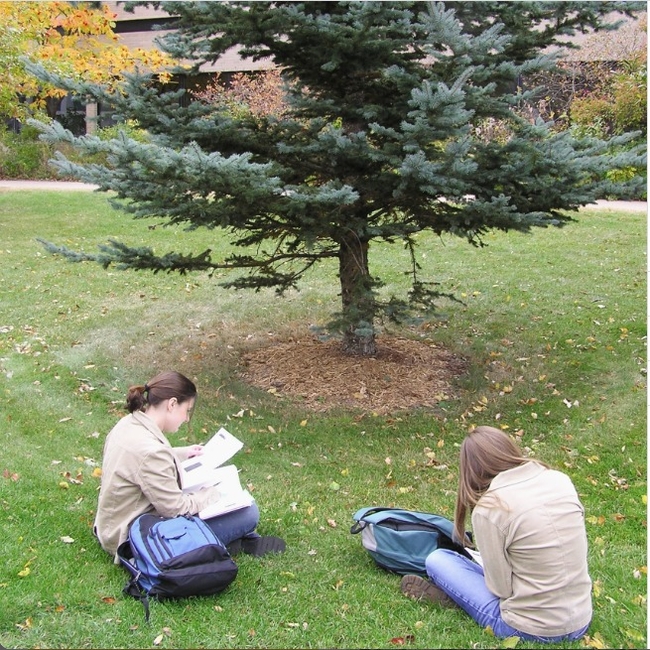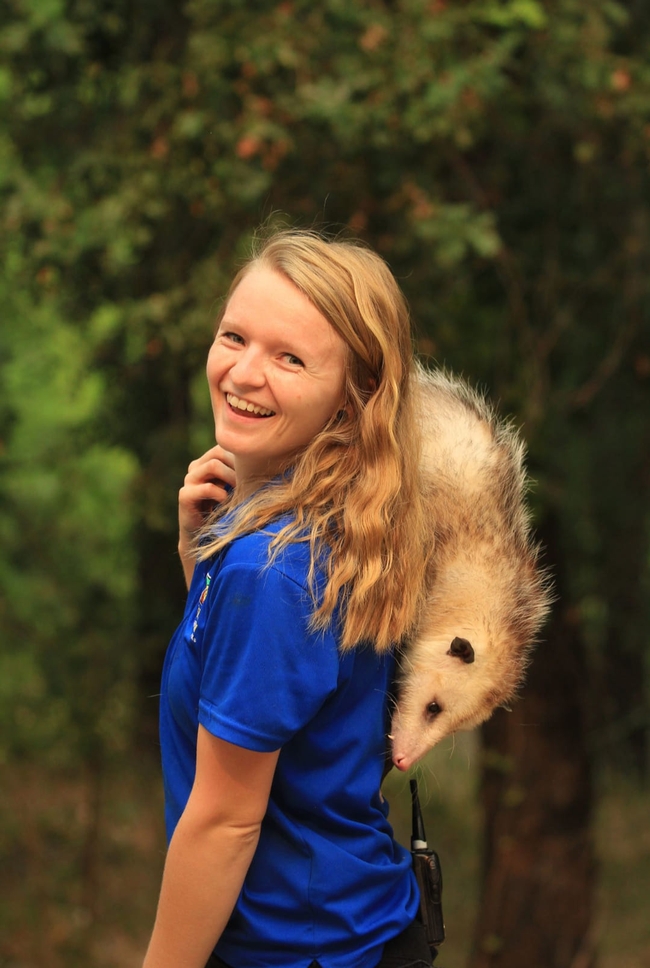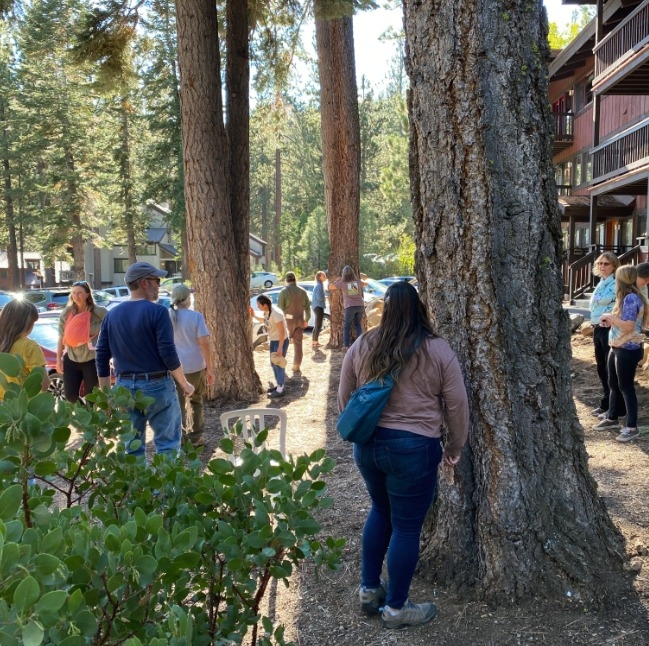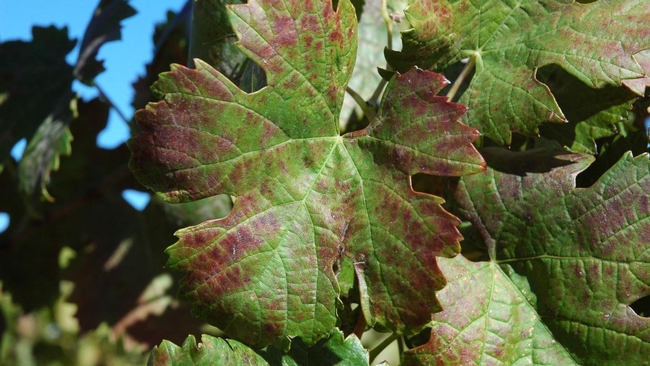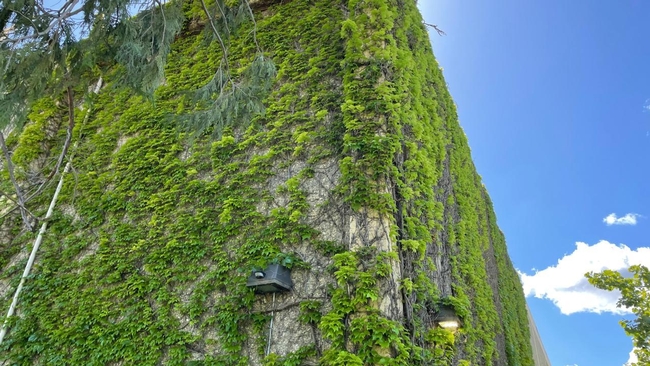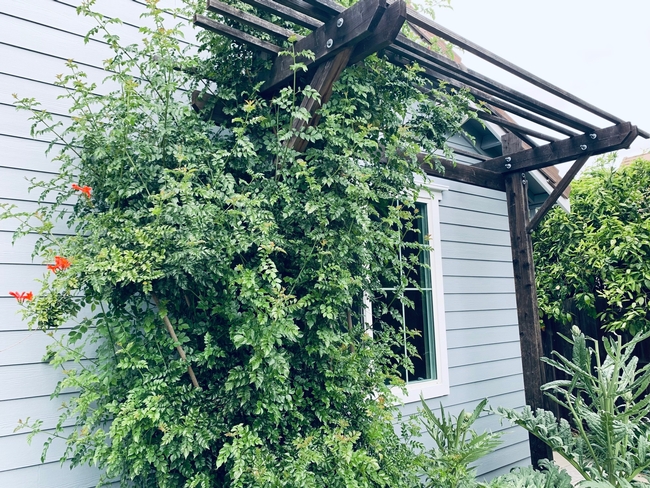Posts Tagged: environmental
Forest research and outreach compiles forestry voices in new story map project
For the past four years, Kim Ingram has been listening closely to the private forest landowners who participate in her Forest Stewardship Workshop series. During the workshops, landowners share their experiences clearing thickets of vegetation, replanting post-wildfire and tackling invasive species, and their concerns of who will take care of their forest when they're gone.
To alleviate their stress, Ingram–Forest Stewardship Education coordinator with University of California Agriculture and Natural Resources–turns to natural resource professionals from CAL FIRE, local Resource Conservation Districts, and the U.S Forest Service who can share knowledge and resources with participants. Recently, Ingram developed a story map that aims to provide landowners with a platform they can use to share their experiences and ways that they have been empowered to manage their land.
"It's not uncommon for small forest landowners to feel overwhelmed with their forest management responsibilities and uncertain over what steps to take first," said Ingram. "Through the Forest Stewardship Workshops and this story map project, we hope to show that there is an entire community of forest landowners in the same situation, learning from each other and moving forward towards their management goals."
The Forest Stewardship Story Map team used ArcGIS StoryMaps to design the project, with 15 participants providing interviews and visual content. StoryMaps provides a user-friendly interface where website visitors can either click on a county to view specific interviews or scroll to view the stories.
The forestry team plans to interview at least one landowner and natural resource professional in every forested county in California so private forest landowners have a local contact or can become inspired by a project in their area.
Theresa Ciafardoni, a forest landowner in Nevada County, said that the UC ANR Forest Stewardship Workshop helped her manage postfire restoration and long-term land use planning.
"It opened up so many options and possibilities," said Ciafardoni. "All the individuals who presented in the Forest Stewardship Workshop were open to phone calls for specific questions and provided invaluable technical assistance."
Involving landowners and forestry professionals with this project was an early decision made by Ingram, who believed it was important that the map held appeal beyond hosting stories. Now, the project functions as a networking tool for landowners seeking professional assistance, too.
Past Forest Stewardship Workshop presenters shared their contact information and the motivations behind their forest management work so that landowners could find assistance in their area. The professionals currently hosted on the map include Resource Conservation District managers, UC ANR forestry advisors and private contractors.
"The most motivated landowners are invested not only economically, but their heart is into it," said Ryan Tompkins, UC Cooperative Extension forestry advisor for Plumas, Sierra and Lassen counties. "The natural world is full of uncertainty, but they're committed to continuing education and learning about how to be a good land steward. This takes a certain level of humility recognizing that our tenure as a steward on the land is a very short period of a forest's lifetime."
Looking ahead, the team envisions the map as a working document that will eventually include interviews with indigenous tribal members who focus on traditional ecological knowledge projects, interviews and information from the UC ANR Postfire Forest Resilience Program, and a feature that will filter stories by topic (e.g. reforestation or prescribed burning).
"This isn't a project that could be completed by one person," explained Grace Dean, Forest Stewardship communications specialist. "The same way that Kim and other presenters explain forest management as a collaborative process holds true for this project."
The Forest Stewardship Workshop series gives participants the ability to start as beginners and build upon their knowledge and experiences. In the same vein, this story map provides the Forest Stewardship team a solid base of real stories to add on to over time. The hope is that it will grow into a multifaceted tool reaching new forest landowners, eventually enveloping their stories within the small forest landowner community.
To view the Forest Stewardship Story Map, visit: https://storymaps.arcgis.com/stories/bd062108d9894da7920d7aef06fe2c2c.
Project Learning Tree: Shaping the future of California forests
On this International Day of Forests, we at UC Cooperative Extension Forest Research and Outreach invite you to celebrate the future of California's trees with us. Considering the recent news coverage regarding tree mortality in California, we want to instead view this subject through a lens of hope. For it's not just the news outlets witnessing the extent of forest die-off: children, especially those in forested communities, are seeing the effects of drought, wildfire, and fire suppression policies in real time.
Project Learning Tree is a national education program leading the next generation to witness and then act on these changes. Children are the future of our forests, and we think the efforts of Project Learning Tree are a cause for celebration, don't you?
Last month, Californians may have noticed a marked uptick in the news coverage of the state's forests. Local, state and national news outlets all reported on the startling approximation of 36 million trees that perished between 2021 and 2022. This number, gleaned from USDA Forest Service data, is a startling jump from the 9.5 million trees that perished the year before. The future of California's forests does not have to look like this, with large fluctuations and ever-rising numbers of dying trees. Right now, it's not easy being a tree. In 10 or 20 years? We're hopeful that the situation is different.
Project Learning Tree (PLT), stretches across the nation to connect students to forests, even if they live miles away from one. Jonelle Mason, the PLT coordinator for Northern California region, provided more insight into the program's purpose through a sentiment many may be familiar with: “To quote Jane Goodall, ‘Only if we understand, will we care. Only if we care, we will help.'” Project Learning Tree is one piece in the future of forest stewardship, and as Jonelle sees it, “Forming forest-education generations creates passionate advocates. People can't save what they don't know about.”
A point touched on by nearly all news outlets covering tree mortality was the centuries of fire suppression practices and its ripple effects that amplify drought and wildfire damage. Students in California are aware of natural disasters affecting forests and forested communities, but not necessarily the causes.Mason posits that in closing that knowledge gap, PLT can “cultivate environmental defenders [who] will ultimately push us in the right direction.”
A crucial aspect of Project Learning Tree is that it exists as a continuing education program, meant to follow students from kindergarten to senior year of high school. Each year of learning builds upon the last, yet the topics are given nuance and depth even at the elementary school level. For instance, PLT's flagship K-8 curriculum gives second grade teachers the tools to communicate ecosystem services, plant structure and natural resource cultivation. High school teachers following the “Focus on Forests” education guide will find avenues to introduce concepts like environmental policy, and will help students understand the difficult decisions that many forest landowners face.
It does indeed give us a reason to celebrate the future. Young people are more active in the conversations surrounding the environment and climate change, and are aware that something must be done to protect the natural resources they have left. It's vital to translate that passion and interest into true learning, where a classroom can become the space for developing ideas for what can be done about our state's forests. Mason is quick to point out the core tenant of PLT that makes it unique: “Teaching students how to think, not what to think, about environmental concerns.”
Project Learning Tree presents concepts to students and gives them the tools to think critically through the many fields that touch forests, from the natural sciences to philosophy. California's youth has a vested interest in protecting and managing their forests, and programs like PLT give us hope that the interest can truly be translated to action.
If you are interested in bringing Project Learning Tree to your school or home, you can contact Mason at jmason@ucanr.edu.
UC Davis to build new $5.25M greenhouse to protect U.S. grapevine collection
Project designed to prevent red blotch and other grapevine diseases
A new, $5.25 million greenhouse is being built on the University of California, Davis, campus to safeguard an important grapevine collection from red blotch disease and other pathogens.
The 14,400-square-foot greenhouse will have a vestibuled entry, be insect-proof and provide another level of disease protection. It is being spearheaded by Foundation Plant Services, or FPS, which provides the U.S. grape industry with high-quality, virus-tested grapevine plant material.
The program serves as the primary source for grapevine plant material distributed to nurseries under the California Department of Agriculture's Grapevine Registration and Certification Program, which provides the majority of grapevines planted in the United States. For the grape industry, it is essential to protect this material from disease-carrying insects and guarantee fast access to clean plant material.
“The program is considered the largest quarantine center for the grapevine industry in the United States,” said Maher Al Rwahnih, a plant pathologist and FPS director. “This is kind of a game changer for us.”
A history of serving the grapevine industry
FPS has maintained healthy grapevine planting stock on the UC Davis campus for more than 70 years in open fields at the Classic and Russell Ranch foundation vineyards. FPS scientists first detected grapevine red blotch virus at Russell Ranch in 2017. By 2021, an estimated 51.6% of the crop there was infected. Material from that vineyard is not being sold, and the site is now part of an epidemiological study to try to pinpoint how the disease is transmitted.
FPS pathologists have detected red blotch on less than 1% of the Classic vineyard crop. But it may not always be that way in the future.
“We don't know how long the Classic vineyard will remain clean,” Al Rwahnih said. “Every testing season, this is what keeps me up at night. We're not sure why it's happening in Russell Ranch and not the Classic vineyard.”
Once the greenhouse is operating, grapevines propagated from plant material from the Classic vineyard will be moved into the greenhouse, tested and verified as clean from disease. From there it will be sold to nurseries, which will grow additional plants to sell to growers.
Two greenhouses part of plan
Normally the foundation has 4,000 vines available, but the greenhouse will only house 2,000 vines, so inventory will be cut in half.
“This phase is just a starting phase,” Al Rwahnih said. “It's not sufficient for our needs.”
FPS plans to build another greenhouse in the next two to three years to increase capacity.
Industry groups and FPS identified greenhouses as the best way to protect the plants from red blotch and other pathogens transmitted by insects. They are also consulting with those same people on the grape varieties to include in the greenhouse.
“We have a large selection, and we need to make sure all the varieties that are important to industry are contained,” he said.
The first greenhouse is expected to be finished by the end of 2023.
Funding for the first greenhouse is coming from a variety of sources. The California Fruit Tree, Nut Tree and Grapevine Improvement Advisory Board, managed by the California Department of Food and Agriculture, contributed $4 million to the project. The California Grape Rootstock Research Foundation gave $500,000, Foundation Plant Services with UC Davis is funding $450,000, and the California Grape Rootstock Commission gave $100,000.
“This is crucial for the grapevine industry, and we are very grateful for the support,” Al Rwahnih said.
Should there be more microbes on your plate?
Scientists make the first large-scale estimate of live microorganisms consumed in the U.S. diet
Our diets provide us with the building blocks we need to stay healthy and fight disease. The nutrients in foods and beverages can be tallied up to know if we are getting what our bodies need. Yet what if a nutrient has been overlooked? For instance, friendly microbes in raw and fermented foods have not been measured as part of our diets — until now.
“Ultimately we want to understand if there should be a recommended daily intake of these microbes to keep us healthy, either through the foods or from probiotic supplements,” said Maria Marco, a professor in the food science and technology department at UC Davis. “In order to do that, we need to first quantify the number of live microorganisms we consume today in our diets.”
Marco co-authored a new study with a group of scientists that examined the number of living microbes per gram of more than 9,000 different foods consumed by nearly 75,000 adults and children. It found that around 20% of children and 26% of adults consumed foods with high levels of live microorganisms in their diet. Both children and adults increased their consumption of these foods over the 18-year study period. The study, published in the Journal of Nutrition, is the first large-scale estimate of how many live microbes are consumed by Americans every day.
“This trend is going in the right direction. Exposure to friendly microorganisms in our foods can be good for promoting a healthy immune system.” said Marco.
Foods for gut health
Study authors examined the National Health and Nutrition Examination Survey to create the estimate. The health and dietary database contains extensive information on the foods consumed by Americans daily. Food science and fermentation experts assigned each food an estimated range of live microbes per gram, creating categories of foods with low, medium and high levels of live microbes. Foods in the high category included fermented dairy foods such as yogurt, fermented pickles and kimchi. Fresh, uncooked fruits and vegetables were also good sources of live microorganisms, represented in the medium category.
The analysis was funded by a grant from the International Scientific Association for Probiotics and Prebiotics, or ISAPP. The microorganisms quantified in this study are not necessarily probiotics.
“By definition, a probiotic must be well-defined and have a demonstrated health benefit at a quantified dose. Live microbes associated with food as a category, however, do not generally meet the criteria of a probiotic,” said corresponding author Mary Ellen Sanders, executive science officer for the ISAPP.
The publication is part of a larger global effort to determine how live dietary microbes might contribute to health.
“There is no doubt that the microbes we eat affect our health. When we think of microbes in our food, we often think of either foodborne pathogens that cause disease or probiotics that provide a documented health benefit,” said co-author Colin Hill, a professor of microbial food safety with University College Cork, Ireland. “But it's important to also explore dietary microbes that we consume in fermented and uncooked foods. It is very timely to estimate the daily intake of microbes by individuals in modern society as a first step towards a scientific evaluation of the importance of dietary microbes in human health and well-being.”
Other scientists co-authoring the paper were ISAPP board members Robert Hutkins, Dan Merenstein, Daniel J. Tancredi, Christopher J. Cifelli, Jaime Gahche, Joanne L. Slavin and Victor L. Fulgoni III.
Editor's note: Maria Marco is affiliated with UC Agriculture and Natural Resources as an Agricultural Experiment Station faculty member.
Can vines speed urban cooling?
Study explores cooling benefits of fast-growing vines as trees take their time
Perhaps trees aren't the only green solution when it comes to cooling urban spaces and reducing energy costs. Honeysuckle, Virginia creeper, pink trumpet and other vines could be a fast-growing substitute in climate-smart cities of the future.
Researchers from UC Davis are leading a nearly $880,000 federal grant to study how vines may provide cooling and shade in Western states in less time than it takes a tree to grow tall.
“Vines can quickly shade buildings and reduce energy consumption while trees slowly grow to maturity,” said Alessandro Ossola, an assistant professor of plant sciences who is a principal investigator for the project. “We believe vines can be an effective and cheap measure to help cities accelerating climate change adaptation.”
The grant from the U.S. Department of Agriculture's Agricultural Marketing Service will fund work to plant and monitor at least 10 types of vines on trellises in five locations in different climate zones over three years. California Department of Food and Agriculture is administering the grant.
Using less water
Water conservation will be vital as populations rise, climate extremes become more prevalent and the demand for agricultural and drinking water increases. The goal of this research is to identify vines that can help save energy by providing cooling and reduce the need for irrigated water.
“In addition to rapid growth rates, vines can be easily integrated with structures to maximize potential cooling effects,” said Loren Oki, a Cooperative Extension specialist with Department of Plant Sciences, who is the project lead. “But we need to understand the relationships between low water-use plants and their ability to reduce thermal loads on buildings.”
The vines will be planted, supported by a trellis and watered regularly during the first growing season to establish deep roots and healthy shoots. Over the next two years, the vines will experience low, moderate and high water allocations.
The vines will be rated on aesthetics, foliage quality, floral quantity, pest and disease resistance, appearance and other factors. Thermal images of trellis coverage and other environmental measurements will also be taken to assess shading and cooling potential, according to grant documents.
Many vines can be grown along cables and wire nets that are actually detached from walls to avoid direct contact and still provide shade, Ossola said.
“We want to understand which vine characteristics relate to fast growth, reduced water use and increased aesthetic appeal,” he added.
Outreach and education
The findings will enable recommendations to be developed for regions, planners, the landscape industry and the public. It could lead to plants being designated as “water-wise,” “low-water use,” “energy-saving” or “cooling.”
Extensive engagement and outreach will also publicize the information.
“Climate change is a great opportunity for the horticultural industry to innovate and promote climate-ready plant productions,” Ossola said.
USDA funding supports research across state lines to find innovative solutions to regional and national problems, USDA Under Secretary for Marketing and Regulatory Programs Jenny Lester Moffitt said in a news release announcing this and other grants.
“This year's funded projects will address a range of those challenges, from energy and water saving in vine plants, finding cost-effective solutions for heat tolerance and drought, to addressing food safety risks for produce,” Moffitt said.
Scientists from the University of Arizona, University of Washington, Utah State University and the South Coast Research and Extension Center at UC Agricultural and Natural Resources are contributing to the research and will be overseeing vine sites in their states.
This article is reprinted from the UC Davis College of Agricultural and Environmental (CA&ES) website, where it is titled "Could Vines Be the Answers to Speeding Urban Cooling, Water Reduction in the West?"

